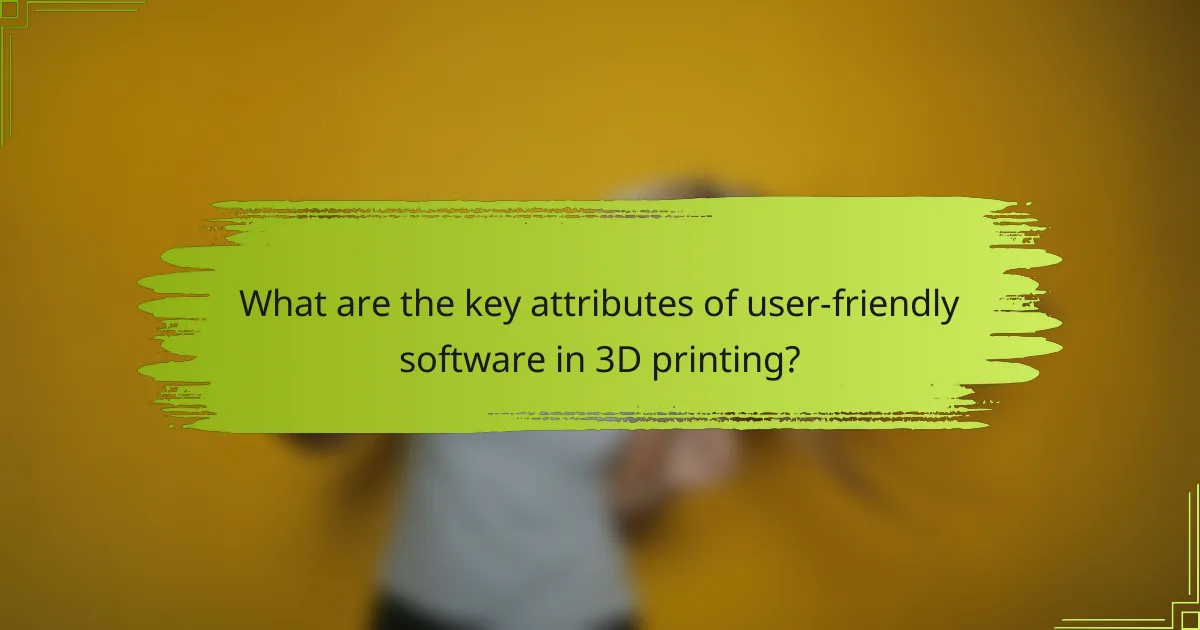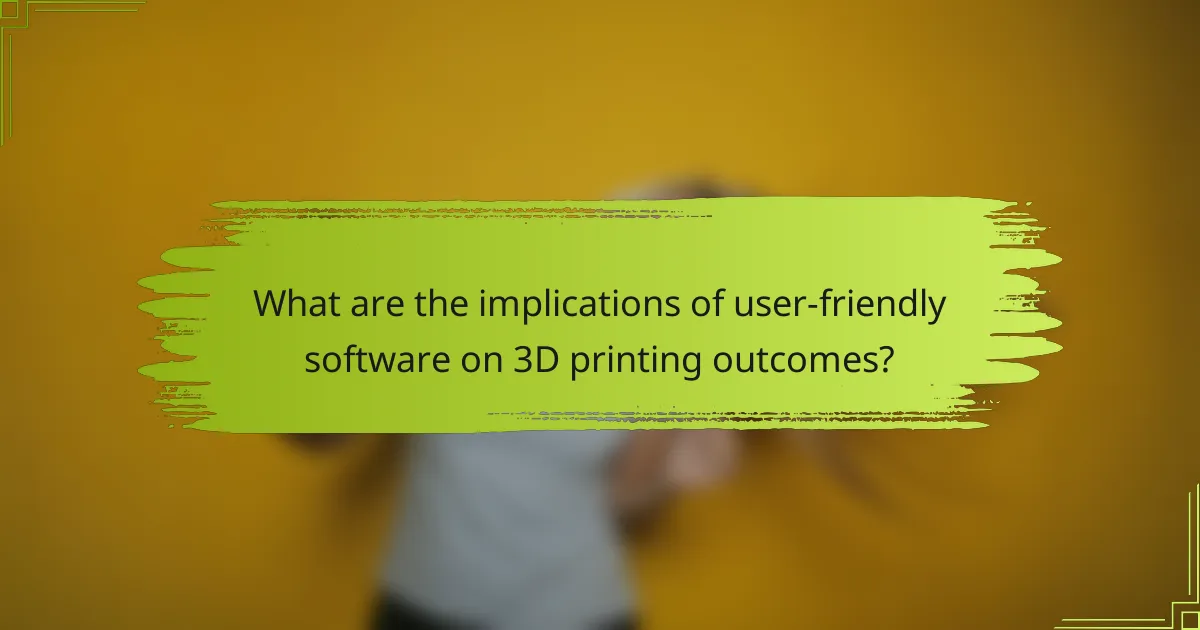
What is User-Friendly Software in 3D Printer Operation?
User-friendly software in 3D printer operation refers to applications designed to simplify the printing process. This type of software often features intuitive interfaces. It allows users to easily navigate through various functions. Common features include drag-and-drop file uploads and guided setup wizards. User-friendly software minimizes the learning curve for new users. It also enhances efficiency for experienced operators. According to a study by the University of Southern California, user-friendly interfaces improve productivity by up to 30%. Thus, such software is essential for effective 3D printing operations.
How does user-friendly software enhance the 3D printing experience?
User-friendly software enhances the 3D printing experience by simplifying the design and printing process. It allows users to easily create, modify, and prepare 3D models for printing. Intuitive interfaces reduce the learning curve for beginners. This accessibility encourages more users to engage in 3D printing. User-friendly software often includes helpful features like guided tutorials and troubleshooting tips. These features minimize errors during the printing process. According to a study by the Journal of 3D Printing Technology, ease of use significantly increases user satisfaction and success rates. Enhanced user experiences lead to more innovation and creativity in 3D printing projects.
What features make software user-friendly for 3D printer operation?
User-friendly software for 3D printer operation includes intuitive interfaces, easy navigation, and clear instructions. Intuitive interfaces allow users to quickly understand the software’s functionalities. Easy navigation helps users access different features without confusion. Clear instructions guide users through setup and printing processes effectively.
Additional features include customizable settings for print quality and speed. These settings enable users to optimize prints based on their specific needs. Real-time monitoring tools provide feedback on print status, enhancing user control. Compatibility with various file formats ensures users can work with different design software.
Support for troubleshooting and FAQs within the software aids users in resolving issues independently. User-friendly software often includes community forums or support channels for additional help. These features collectively enhance the overall user experience, making 3D printing more accessible to a broader audience.
How does user-friendly software impact user learning curves?
User-friendly software significantly reduces user learning curves. Intuitive interfaces allow users to navigate easily without extensive training. This leads to quicker adaptation and increased confidence in using the software. Studies show that users can complete tasks 30% faster with user-friendly designs. Additionally, clear instructions and visual aids enhance understanding. As a result, users experience fewer errors and frustrations. This efficiency is critical in 3D printer operation, where precision is paramount. Ultimately, user-friendly software fosters a more productive and satisfying user experience.
Why is user-friendly software crucial for 3D printer users?
User-friendly software is crucial for 3D printer users because it simplifies the printing process. Many users lack technical expertise. Intuitive interfaces enable quick learning and efficient operation. This reduces the likelihood of errors during setup and printing. Studies show that user-friendly software can increase productivity by up to 30%. Additionally, it enhances user satisfaction and encourages more individuals to engage with 3D printing technology. Overall, accessible software fosters creativity and innovation in design.
What challenges do users face without user-friendly software?
Users face significant challenges without user-friendly software in 3D printer operation. These challenges include increased frustration due to complex interfaces. Users often struggle to navigate intricate settings. This can lead to improper printer configurations. As a result, users may experience frequent print failures. Additionally, a lack of intuitive guidance can hinder troubleshooting efforts. Users may find it difficult to access essential features. This can limit their ability to optimize print quality. Ultimately, these challenges can discourage users from fully utilizing their 3D printers.
How does user-friendly software contribute to efficiency in 3D printing?
User-friendly software significantly enhances efficiency in 3D printing by simplifying the design and printing processes. It allows users to easily create and modify 3D models without extensive technical knowledge. Intuitive interfaces reduce the learning curve for new users. This leads to faster project turnaround times. Additionally, streamlined workflows minimize errors during the printing process. Effective software often includes built-in troubleshooting features, which help resolve issues quickly. According to a study by Wohlers Associates, user-friendly software can decrease production times by up to 30%. This efficiency ultimately results in cost savings and improved productivity for users.

What are the key attributes of user-friendly software in 3D printing?
User-friendly software in 3D printing has several key attributes. Intuitive interface design simplifies navigation for users. Clear instructions and tooltips enhance user experience. Compatibility with various file formats increases versatility. Real-time monitoring provides instant feedback during printing. Customization options allow users to modify settings easily. Support for troubleshooting aids in resolving issues promptly. Community resources and tutorials offer additional learning support. These attributes collectively improve accessibility and efficiency for users in 3D printing.
What design principles are essential for user-friendly software?
User-friendly software is designed with several essential principles. These principles include simplicity, consistency, feedback, accessibility, and user control. Simplicity ensures that the interface is easy to understand and navigate. Consistency allows users to predict how the software will behave based on their past interactions. Feedback provides users with information about their actions, confirming that tasks are completed successfully. Accessibility ensures that all users, regardless of ability, can use the software effectively. User control empowers users to make choices and customize their experience. These principles enhance usability and improve user satisfaction in software applications, particularly in contexts like 3D printer operation.
How do intuitive interfaces affect user satisfaction?
Intuitive interfaces significantly enhance user satisfaction. They simplify navigation and reduce the learning curve for users. When users can easily understand how to operate software, they experience less frustration. Research indicates that user-friendly designs lead to higher engagement rates. According to a study by Nielsen Norman Group, 94% of first impressions relate to design. A positive first impression often translates to increased user satisfaction. Furthermore, intuitive interfaces contribute to a more efficient workflow. Users can complete tasks faster, leading to a sense of accomplishment. Overall, intuitive interfaces are crucial for maximizing user satisfaction in software applications.
What role does accessibility play in user-friendly software design?
Accessibility is crucial in user-friendly software design as it ensures that all users, including those with disabilities, can effectively interact with the software. It involves implementing features like screen readers, keyboard navigation, and adaptable interfaces. These features enhance usability for individuals with visual, auditory, or motor impairments. Research shows that accessible design improves overall user satisfaction and engagement. According to the World Health Organization, over 1 billion people live with some form of disability, highlighting the need for inclusive design. Adopting accessibility standards, such as the Web Content Accessibility Guidelines (WCAG), further supports this goal. This approach not only benefits users with disabilities but also enhances the experience for all users.
How does user feedback influence software development?
User feedback significantly influences software development by guiding design and functionality improvements. Developers analyze user input to identify pain points and areas for enhancement. This feedback loop allows for iterative updates that align the software with user needs. For instance, a study by Nielsen Norman Group found that user testing can reveal usability issues that developers may overlook. Incorporating user feedback leads to higher satisfaction and better adoption rates. Ultimately, responsive software development driven by user feedback fosters a more user-friendly experience.
What methods are used to gather user feedback effectively?
Surveys and questionnaires are effective methods to gather user feedback. They can be distributed online or in-person. Open-ended questions allow users to express their thoughts freely. Closed questions provide quantitative data for analysis. Interviews enable deeper insights through direct interaction. Focus groups facilitate discussion among users for diverse perspectives. Usability testing observes users in real-time as they interact with software. Analytics tools track user behavior and engagement patterns. Each method provides valuable data to improve user-friendly software in 3D printer operation.
How can software updates improve user experience over time?
Software updates can significantly enhance user experience over time. They often include bug fixes that resolve existing issues. This leads to smoother operation and fewer disruptions. Updates may also introduce new features that improve functionality. For instance, enhanced user interfaces can make software more intuitive. Additionally, performance optimizations can speed up processes, making tasks more efficient. Security patches protect user data and enhance trust in the software. Over time, these improvements contribute to a more satisfying and reliable user experience. Regular updates are essential for maintaining software relevance and usability in evolving technological landscapes.

What are the implications of user-friendly software on 3D printing outcomes?
User-friendly software significantly enhances 3D printing outcomes. It simplifies the design and printing processes for users. This accessibility leads to fewer errors in model preparation. Reduced errors result in higher print quality and accuracy. User-friendly interfaces often include tutorials and guides. These resources help users understand complex functionalities. As a result, users can produce intricate designs with confidence. Studies show that intuitive software increases user satisfaction and productivity.
How does user-friendly software affect print quality?
User-friendly software enhances print quality by simplifying the user interface and optimizing settings. It allows users to easily adjust parameters like layer height and print speed. This accessibility reduces the likelihood of user error. When users can intuitively navigate the software, they can better fine-tune print settings. Improved adjustments lead to more precise prints with better surface finishes. Studies show that user-friendly software can increase user satisfaction and reduce print failures. Higher satisfaction correlates with improved print quality outcomes. Overall, user-friendly software directly contributes to achieving superior print results in 3D printing.
What specific software features contribute to improved print quality?
Software features that contribute to improved print quality include advanced slicing algorithms, customizable print settings, and real-time monitoring capabilities. Advanced slicing algorithms optimize the path of the printer head, reducing travel time and enhancing precision. Customizable print settings allow users to adjust parameters like layer height and print speed, which can significantly affect the final output. Real-time monitoring capabilities enable users to track print progress and make adjustments on-the-fly, ensuring consistency and quality. Additionally, support for multiple file formats ensures compatibility with various 3D models, further enhancing print quality.
How can software help in troubleshooting printing issues?
Software can assist in troubleshooting printing issues by providing diagnostic tools and error reporting features. These tools can identify common problems such as connectivity issues, paper jams, or incorrect settings. For example, many printer software applications include a troubleshooting wizard that guides users through resolving specific issues. Additionally, software can update printer drivers automatically, ensuring compatibility and optimal performance. Error logs generated by the software can help technicians analyze recurring problems. Some software solutions offer remote access capabilities, allowing support teams to diagnose issues without being physically present. Overall, user-friendly software simplifies the troubleshooting process and enhances printer reliability.
What best practices should users follow to maximize software benefits?
To maximize software benefits, users should engage in regular training and updates. Regular training ensures familiarity with features and functions. Keeping software updated enhances performance and security. Users should also customize settings to suit their specific needs. Customization can improve efficiency and usability. Additionally, utilizing support resources can resolve issues quickly. Accessing tutorials and forums provides valuable insights. Finally, users should back up data regularly to prevent loss. Data backups safeguard against unexpected failures.
How can users effectively utilize tutorials and support resources?
Users can effectively utilize tutorials and support resources by following structured steps. First, they should identify the specific issue or topic they need assistance with. This helps in selecting the most relevant tutorial or resource. Next, users should engage with the content actively. This means taking notes or pausing videos to practice along. They should also explore different formats, such as videos, articles, or forums, to find what works best for their learning style. Additionally, users can join community forums for real-time support and shared experiences. Lastly, they should apply what they learn immediately in their 3D printing tasks to reinforce their understanding. This approach enhances retention and practical skills.
What are common troubleshooting tips for user-friendly software in 3D printing?
Common troubleshooting tips for user-friendly software in 3D printing include checking software compatibility with the printer. Ensure the correct settings are applied for the specific material being used. Verify that the printer firmware is up to date. Restart both the software and the printer to resolve temporary glitches. Review the slicer settings for errors in layer height or print speed. Inspect the model for errors using built-in repair tools. Consult user forums or documentation for specific issues related to the software. These steps can help in diagnosing and resolving common problems effectively.
User-friendly software is essential in 3D printer operation, as it simplifies the printing process through intuitive interfaces and clear instructions. This software enhances user experience by minimizing learning curves, reducing errors, and increasing productivity by up to 30%. Key features include customizable settings, real-time monitoring, and troubleshooting support, which collectively improve print quality and user satisfaction. The article will explore the impact of user-friendly software on efficiency, learning, and overall 3D printing outcomes, as well as best practices for users to maximize its benefits.